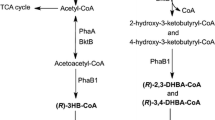Abstract
Various aerobic Gram-negative bacteria were analysed for utilizing 4-hydroxyhexanoic acid (4HHx) as a carbon source for growth and for synthesis of polyhydroxyalkanoic acids (PHA). Although many wild types grew on 4HHx, only recombinant strains of the PHA-negative mutants Pseudomonas putida GPp104 and Alcaligenes eutrophus PHB−4, which harboured plasmid pHP1014::E156 with the PHA-biosynthesis genes of Thiocapsa pfennigii, incorporated 4HHx up to a molar fraction of 47 or 1.4%, respectively, into PHA if the cells were cultivated in the presence of 4HHx as sole carbon source and under nitrogen starvation. A terpolyester consisting of 3-hydroxybutyric acid (3HB), 3-hydroxyhexanoic acid (3HHx) and 4HHx was synthesized, as revealed by gas chromatographic analysis of the accumulated polyester and as confirmed by nuclear magnetic resonance spectroscopic analysis of the isolated polyester. 4HHx was also detected in PHA accumulated by Rhodococcus ruber if 4HHx was used as a carbon source. However, it occurred at a molar fraction of maximally 1.3 mol% only beside 3HB, 3-hydroxyvaleric acid and 3HHx.
Similar content being viewed by others
References
Anderson AJ, Dawes EA (1990) Occurrence, metabolism, metabolic role and industrial uses of bacterial polyhydroxyalkanoates. Microbiol Rev 54:450–472
Bluhm TL, Hamer GK, Marchessault RH, Fyfe CA, Veregin RP (1986) Isodimorphism in bacterial poly(β-hydroxybutyrate-co-β-hydroxyvalerate). Macromolecules 19:2871–2876
Brandl H, Gross RA, Lenz RW, Fuller RC (1988) Pseudomonas oleovorans as a source of poly(β-hydroxyalkanoates) for potential applications as biodegradable polyesters. Appl Environ Microbiol 54:1977–1982
Doi Y, Kunioka M, Nakamura Y, Soga K (1986) Nuclear magnetic resonance studies on poly(β-hydroxybutyrate) and a copolyester of β-hydroxybuytrate and β-hydroxyvalerate isolated from Alcaligenes eutrophus H16. Macromolecules 19:2860–2864
Doi Y, Tamaki A, Kunioka M, Soga K (1987) Biosynthesis of terpolyesters of 3-hydroxybutyrate, 3-hydroxyvalerate and 5-hydroxyvalerate in Alcaligenes eutrophus from 5-chloropentanoic and pentanoic acids. Makromol Chem Rapid Commun 8:631–635
Doi Y, Kunioka M, Nakamura Y, Soga K (1988) Nuclear magnetic resonance studies on unusual bacterial copolyesters of 3-hydroxybutyrate and 4-hydroxybutyrate. Macromolecules 21:2722–2727
Don RA, Pemperton JM (1981) Properties of six pesticide degradation plasmids isolated from Alcaligenes paradoxus and Alcaligenes eutrophus. J Bacteriol 145:681–686
Gross RA, De Mello C, Lenz RW, Brandl H, Fuller RC (1989) Biosynthesis and characterization of poly(β-hydroxyalkanoates) produced by Pseudomonas oleovorans. Macromolecules 22:1106–1115
Haywood GW, Anderson AJ, Williams DR, Dawes EA, Ewing DF (1991) The accumulation of a polyhydroxyalkanoate copolymer containing primarily 3-hydroxyvalerate from simple carbohydrate substrates by Rhodococcus sp. NCIMB 40126. Int J Biol Macromol 13:83–88
Huisman GW, Wonink E, Meinma R, Kazemier B, Terpstra P, Witholt B (1991) Metabolism of poly(3-hydroxyalkanoates) by Pseudomonas oleovorans: identification and sequences of genes and function of the encoded proteins in the synthesis and degradation of PHA. J Biol Chem 266:2191–2198
Kunioka M, Nakamura Y, Doi Y (1988) New bacterial copolyesters produced in Alcaligenes eutrophus from organic acids. Polymer Commun 29:174–176
Liebergesell M, Hustede E, Timm A, Steinbüchel A, Fuller RC, Lenz RW, Schlegel HG (1991) Formation of poly(3-hydroxyalkanoates) by Phototrophic and chemolithotrophic bacteria. Arch Microbiol 155:415–421
Liebergesell M, Mayer F, Steinbüchel A (1993) Analysis of polyhydroxyalkanoic acid-biosynthesis genes of anoxygenic phototrophic bacteria reveals synthesis of a polyester exhibiting an unusual composition. Appl Microbiol Biotechnol, in press
Patt SL, Shoolery JN (1982) Attached proton test for carbon-13 NMR. J Magn Reson 46:535–539
Pieper U, Steinbüchel A (1992) Identification, cloning and sequence analysis of the poly(3-hydroxyalkanoic acid) synthase gene of the Gram-positive bacterium Rhodococcus ruber. FEMS Microbiol Lett 96:73–80
Preusting H, Nijenhuis A, Witholt B (1990) Physical characteristics of poly(3-hydroxyalkanoates) and poly(3-hydroxyalkenoates) produced by Pseudomonas oleovorans grown on aliphatic hydrocarbons. Macromolecules 23:4220–4224
Reynolds WF, Hughes DW, Perpick-Dumont M (1985) A pulse sequence which provides rapid, routine 1H-13C shift-correlated spectra. J Magn Reson 64:304–311
Schirmer A, Jendrossek D, Schlegel HG (1993) Degradation of poly(3-hydroxyoctanoic acid) [P(3HO)] by bacteria: purification and properties of a P(3HO) depolymerase from Pseudomonas fluorescens GK13. Appl Environ Microbiol 59:1220–1227
Schlegel HG, Kaltwasser H, Gottschalk G (1961) Ein Submersverfahren zur Kultur wasserstoffoxydierender Bakterien: Wachstumsphysiologische Untersuchungen. Arch Mikrobiol 38:209–222
Steinbüchel A (1991a) Polyhydroxyalkanoic acids. In: D Byrom (ed) Biomaterials. Macmillan, New York, pp 123–213
Steinbüchel A (1991b) Polyhydroxyfettsäuren — thermoplastisch verformbare Polyester aus Bakterien. Nachrichtenbl Chem Tech Labor 39:1112–1124
Steinbüchel A, Hustede E, Liebergesell M, Pieper U, Timm A, Valentin H (1992) Molecular basis for biosynthesis and accumulation of polyhydroxyalkanoic acids in bacteria. FEMS Microbiol Rev 103:217–230
Timm A, Byrom D, Steinbüchel A (1990) Formation of blends of various poly(3-hydroxyalkanoic acids) by a recombinant strain of Pseudomonas olevorans. Appl Microbiol Biotechnol 33:296–301
Valentin HE, Schönebaum A, Steinbüchel A (1992) Identification of 4-hydroxyvaleric acid as a constituent of biosynthetic polyhydroxyalkanoic acids from bacteria. Appl Microbiol Biotechnol 36:507–514
Worsey MJ, Williams PA (1975) Metabolism of toluene and the xylenes by Pseudomonas putida (arvilla) mt-2: evidence for a new function of the TOL plasmid. J Bacteriol 124:7–13
Author information
Authors and Affiliations
Additional information
Correspondence to: A. Steinbüchel
Rights and permissions
About this article
Cite this article
Valentin, H.E., Lee, E.Y., Choi, C.Y. et al. Identification of 4-hydroxyhexanoic acid as a new constituent of biosynthetic polyhydroxyalkanoic acids from bacteria. Appl Microbiol Biotechnol 40, 710–716 (1994). https://doi.org/10.1007/BF00173333
Received:
Accepted:
Issue Date:
DOI: https://doi.org/10.1007/BF00173333




